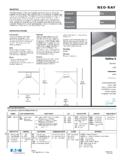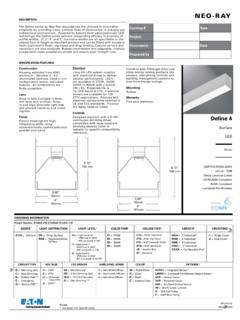Transcription of BY ORDER OF THE AIR FORCE MANUAL 33-363 SECRETARY …
1 BY ORDER OF THE AIR FORCE MANUAL 33-363 . SECRETARY OF THE AIR FORCE 1 MARCH 2008 . Communications and information management OF RECORDS. COMPLIANCE WITH THIS PUBLICATION IS MANDATORY. ACCESSIBILITY: Publications and forms are available for downloading or ordering on the e-Publishing website at RELEASABILITY: There are no releasability restrictions on this publication. OPR: SAF/XCPPA Certified by: SAF/XCPP (Mr Albert Bodnar). Supersedes AFMAN37-123, 31 August 1994 Pages: 59. This MANUAL implements Department of Defense (DoD) Directive (DoDD) , DoD Records Man- agement Program, and Air FORCE Policy Directive (AFPD) 33-3, information management . It establishes the requirement to use the Air FORCE Records information management System (AFRIMS); establishes guidelines for managing all records (regardless of media); and defines methods and the format for record storage, file procedures, converting paper records to other media or vice versa, and outlines the minimum to comply with records management legal and policy requirements.
2 This publication applies to all Air FORCE military, civilians, and contractor personnel under contract by the DoD who create records in their area of responsibility (AOR), including the Air FORCE Reserve Command units and its members, civilians and contractors, the Air National Guard and Air FORCE components assigned to the combatant commands that are not directly responsive to the Combatant Commanders; and to contractors by contract or other legally binding action, wherever an Air FORCE contract provides for the operation of a system of records or portion of a system of records to accomplish an Air FORCE function. information in this MANUAL is directed by Air FORCE Instruction (AFI) 33-364, Records Disposition--Procedures and Responsibilities, and may result in updates to other Air FORCE Instructions. Chapter 6 contains standardized processes for handling records in the during major deployments and fulfills the Air FORCE responses to the Audit on Global War on Terrorism, Project and Audit on Shared Network Storage management , Project conducted by the Air FORCE Audit Agency.
3 Send recommended changes or comments to Headquarters Air FORCE Communications Agency (HQ AFCA/EASD), 203 W. Losey St, Room 1100, Scott AFB IL 62225-5222, through appropriate channels, using Air FORCE (AF) Form 847, Recommendation for Change of Publication, with an information copy or record copy to SECRETARY of the Air FORCE , Air FORCE Records Office (SAF/XCPPA), 1401 North Wilson Blvd, Suite 601, Arlington, VA. 22209. Ensure that all records created as a result of processes prescribed in this publication are maintained in accordance with this MANUAL , and are disposed of in accordance with the AFRIMS Records Disposition Schedule (RDS) located at The use of the name or mark of any specific manufacturer, commercial product, commodity, or service in this publication does not imply endorsement by the Air FORCE . Attachment 1 contains a glossary of references and supporting informa- tion. 2 AFMAN33-363 1 MARCH 2008 . SUMMARY OF CHANGES. This document is substantially revised and must be completely reviewed.
4 It establishes new require- ments; directs use of the Electronic Records management (ERM) Solution Guide, updates, clarifies, and streamlines previous guidance and requirements; and provides new terminology and definitions. Chapter 1 OBJECTIVES AND RESPONSIBILITIES 5. Record management Basics.. 5. Duties and Responsibilities.. 5. Record Maintenance Technologies.. 5. Chapter 2 AIR FORCE RECORDS information management SYSTEM. (AFRIMS) 6. Air FORCE Records information management System (AFRIMS).. 6. Air FORCE Records information management System (AFRIMS) File 6. File Cut-off Procedures.. 7. Electronic and Other Non-Paper Records and Record Objects.. 7. Figure Computer Directory Showing Office Subdirectories.. 9. Chapter 3 PLANNING AND ARRANGING RECORDS 10. Office Arrangement.. 10. Basic Filing Arrangement.. 10. General Correspondence File.. 10. Standardization.. 10. File Drawers.. 10. Charge Out Records.. 11. Instructions for Using Guide Cards, Folders, and Labels.
5 11. Chapter 4 FILING PROCEDURES RECORDS 13. Preparing Records for Filing.. 13. Figure Document Showing Authorization and Code for Filing (Including Cross-Reference Designation).. 13. Cross References.. 14. Filing Classified Records.. 14. Files Cut-off Procedures.. 14. File Plans for Deployed Units.. 14. AFMAN33-363 1 MARCH 2008 3. Chapter 5 FILING SUPPLIES AND EQUIPMENT 15. Filing Supplies and Equipment.. 15. Standard Filing Supplies.. 15. Table Items to Use in Maintaining File Plans.. 15. Suggested Standard Filing Equipment.. 15. Shelf-Filing Equipment.. 16. Procedures for Requesting and Controlling Filing Equipment and Nonstandard Filing Supplies.. 16. Chapter 6 MANAGING ELECTRONICALLY STORED information (ESI) 17. Objectives.. 17. Life Cycle management of E-Records.. 21. Record management Roles and Responsibilities.. 21. Figure Sample AF Form 1341, Electronic Record Inventory.. 22. Contractor Support.. 23. Electronic Record Keeping (ERK) Systems 23.
6 Documentation.. 24. Electronic Record Keeping (ERK) Decisions.. 24. Vulnerability of Electronically Stored information (ESI).. 24. Maintaining and Preserving Electronically Stored information (ESI).. 24. Selection and Maintenance of Magnetic Storage Media.. 25. Official Records on Personally-Owned Computers, Hand-Held and 26. Judicial Use of Records.. 27. E-Record System Integrity.. 27. Security of Electronic Records (E-Records).. 27. Web Records and Web Pages.. 28. Figure Sample of AF Form 525, Records Disposition Recommendation (Front).. 29. Figure Sample of AF Form 525, Records Disposition Recommendation (Reverse).. 30. Table Sample of Decision Logic Table to Accompany AF Form 525.. 31. Duplicate Records on Mixed Media.. 31. Records Integration.. 31. Cross-Referencing.. 31. Appropriate Storage Media for Electronic Records (E-Records).. 31. 4 AFMAN33-363 1 MARCH 2008 . Retention Standards.. 32. Schedule Disposition.. 32. Setting Up Official Electronic Records (E-Records).
7 32. Scheduling Planned or Operational Systems.. 32. Destroying Electronic Records (E-Records).. 32. Transferring Electronic Records (E-Records) to National Archives and Records Administration (NARA).. 32. Figure Sample NA Form 14097, Technical Description for Transfer of Electronic Records to the National Archives.. 34. Retirement to the Federal Record Centers (FRC).. 35. Prescribed Forms.. 35. Adopted Forms.. 35. Attachment 1 GLOSSARY OF REFERENCES AND SUPPORTING. information 36. Attachment 2 INSTRUCTIONS FOR COMPLETING THE STANDARD FORM. (SF) 135, RECORDS TRANSMITTAL AND RECEIPT 51. Attachment 3 AIR FORCE RECORDS STORAGE FACILITIES (STATUTORY. AUTHORITY: 36 CFR, PART 1228, RECORDS CENTER FACILITY. STANDARDS) 53. Attachment 4 SAF/XC POLICY MEMO AR-M350_20070829 ON E-DISCOVERY. RULES 55. Attachment 5 VITAL RECORDS PLAN 57. Attachment 6 RECORD SEARCH PROCEDURES 58. AFMAN33-363 1 MARCH 2008 5. Chapter 1. OBJECTIVES AND RESPONSIBILITIES. Record management Basics.
8 Records are created by military, civilian, and contractor Air FORCE employees. Record types include Draft records--those that can be altered and have not been signed or officially released; and Final records--those that have been signed, officially released and cannot be altered. Air FORCE employees have three basic obligations regarding records: (1) Create records needed to do the business of the agency, reflect record decisions and actions taken, and/or document activities for which they are responsible; (2) manage records by setting up directories and files, and filing materials (in any format) regularly and carefully in a manner that allows safe storage and efficient retrieval when nec- essary; and (3) ensure records are maintained in accordance with this MANUAL , and disposed of in accor- dance with the AFRIMS RDS (located at ) and related Federal regulations and legal requirements. This MANUAL outlines the principles of applying electronic records (e-records) management (ERM) by using existing resources and prepares your organization for transition to an Enterprise information management (EIM) tool suite; provides standards for preserving, protecting and disposing of Air FORCE records in/on electronic media or any other media and incorporating those standards into each life cycle phase of the record.
9 Records are media neutral and include all information that can document business performance or transactions; was made or received in the performance of duties; and could affect or impact a process, program, decision, etc. Duties and Responsibilities. Refer to AFI 33-322, Records management Program. Record Maintenance Technologies. Records are the information that we preserve and manage. Technology has revolutionized the flow of communication and significantly contributed to the challenges of managing records in media other than paper. Various automated systems already store information as records. Conversion of paper documents to electronic format such as microform, optical disk, video disk, compact disk (CD), digital versatile disk (DVD), as well as scanning documents to a portable document format (PDF) are acceptable. Electronic records are the media of choice for use, storage and maintenance. Create new paper records after receiving approval by the Air FORCE Record Officer (AFRO).
10 Requests must include justification compliant with the exemptions specified in the Government Paperwork Reduc- tion Act, Government Paperwork Elimination Act (GPEA), E-Government Initiatives; and DoD and Air FORCE Net-Centric Strategies. Existing paper records may be destroyed after scanning to an approved for- mat and validating content, or imputing information in an electronic record keeping system (ERKS). A. concerted effort should be made to reduce paper storage across the Enterprise. Chapter 2 and Chapter 6. provide guidance on using AFRIMS to manage all records, and the structure of records to transition to the Air FORCE EIM Solution. 6 AFMAN33-363 1 MARCH 2008 . Chapter 2. AIR FORCE RECORDS information management SYSTEM (AFRIMS). Air FORCE Records information management System (AFRIMS). AFRIMS is the mandatory, unclassified, web-based tool suite, Government-Owned Technology Software designed to enhance and standardize Air FORCE records management and procedures.
















